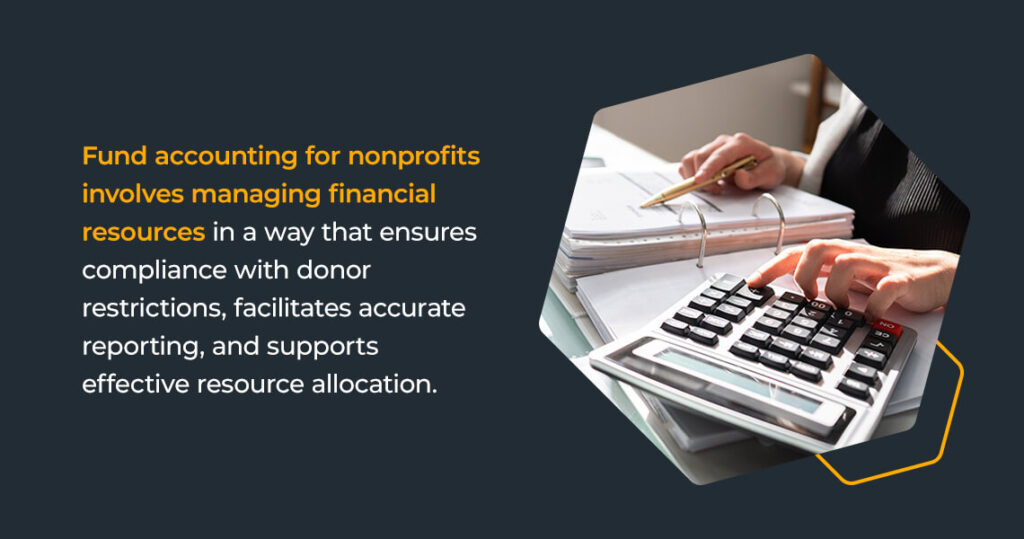Reading Time: 6 minutes
Managing finances is a critical aspect of nonprofit organizations, and accurate and transparent accounting practices are essential for maintaining trust and accountability. One key accounting approach specifically designed for nonprofits is fund accounting. Discover the basics of fund accounting below.
General Accounting vs. Fund Accounting
General accounting and fund accounting are two distinct approaches to financial management, each with a specific purpose and application. Here’s a comparison between general accounting and fund accounting:
Key factors of general accounting include:
- Purpose: General accounting focuses on capturing and reporting an organization’s overall financial activities and performance.
- Approach: General accounting combines all financial transactions and activities into a single, consolidated set of accounts, typically referred to as the general ledger.
- Scope: General accounting encompasses all financial aspects of an organization, including revenue, expenses, assets, liabilities, and equity.
- Reporting: Financial statements prepared under general accounting principles, such as the income statement, balance sheet, and cash flow statement, provide an overview of the organization’s financial health and performance.
- Applicability: General accounting is commonly used in for-profit entities, where the focus is on profitability and generating returns for shareholders or owners.
Key factors of fund accounting include:
- Purpose: Fund accounting is specifically designed for nonprofit organizations and focuses on tracking and managing resources by separate funds.
- Approach: Fund accounting segregates financial transactions and activities into different funds based on their source, purpose, or donor-imposed restrictions.
- Scope: Fund accounting captures and reports on the financial activities of each individual fund, ensuring compliance with donor restrictions and facilitating accurate reporting.
- Reporting: Nonprofit organizations typically prepare separate financial statements for each fund, allowing stakeholders to understand the allocation and utilization of restricted and unrestricted resources.
- Applicability: Fund accounting is predominantly used in the nonprofit sector, where organizations receive and manage funds with specific purposes, donor restrictions, or project requirements.
Here are the most notable differences between general and fund accounting:
- Segregation of funds: Fund accounting requires the segregation of financial activities into different funds, while general accounting consolidates all activities into a single set of accounts.
- Focus on compliance: Fund accounting places a strong emphasis on compliance with donor restrictions and tracking the use of restricted funds, whereas general accounting focuses more broadly on financial performance and profitability.
- Reporting requirements: Fund accounting necessitates separate reporting for each fund, providing transparency and accountability for the utilization of funds, while general accounting typically provides consolidated financial statements for the entire organization.
- Nonprofit vs. for-profit: Fund accounting is primarily used in nonprofit organizations, whereas general accounting is commonly employed in for-profit entities.
Nonprofit Fund Accounting Basics
The purpose of fund accounting is to track and manage financial resources within an organization based on their designated purpose, source, or donor-imposed restrictions. The primary objectives of fund accounting include:
- Accountability: Fund accounting ensures transparency and accountability in the use of funds. By tracking financial resources separately, organizations can demonstrate how funds are allocated, expended, and reported in accordance with donor requirements or specific project purposes.
- Compliance: Fund accounting enables organizations to comply with legal, regulatory, and donor restrictions. Nonprofit organizations often receive funds earmarked for specific programs or initiatives, and fund accounting ensures these funds are used in accordance with the donor’s intentions and any legal or contractual obligations.
- Financial reporting: Fund accounting facilitates accurate and comprehensive financial reporting. By maintaining separate fund accounts and generating fund-specific financial statements, organizations can provide stakeholders, including donors, board members, and regulatory authorities, with detailed insights into the utilization and impact of funds.
- Budgeting and resource management: Fund accounting supports effective budgeting and resource management. By segregating financial resources into different funds, organizations can allocate resources strategically, monitor fund balances, and ensure funds are available to support specific programs or projects.
- Decision-making: Fund accounting provides organizations with the financial data and insights needed to make informed decisions. By analyzing the financial performance of individual funds, organizations can assess the viability and effectiveness of specific programs or initiatives, identify areas of improvement, and allocate resources optimally.
- Donor relations: Fund accounting helps maintain strong relationships with donors. By accurately tracking and reporting on the use of restricted funds, organizations can demonstrate their commitment to donor stewardship, compliance, and impact, thereby fostering trust and encouraging continued donor support.
The Basics of Fund Accounting for Nonprofits

Fund accounting for nonprofits involves managing financial resources in a way that ensures compliance with donor restrictions, facilitates accurate reporting, and supports effective resource allocation. Here are the fund accounting basics for nonprofits:
- Fund structure: Nonprofits typically have multiple funds, each representing a distinct purpose or source of funding. Common types of funds include unrestricted funds, temporarily restricted funds, and permanently restricted funds. Establish separate accounts for each fund to accurately track financial transactions.
- Restricted vs. unrestricted funds: Restricted funds are subject to specific donor-imposed restrictions, such as limitations on their use or time restrictions. Unrestricted funds can be used at the organization’s discretion. Maintain a clear distinction between restricted and unrestricted funds to ensure compliance and proper allocation.
- Chart of accounts: Developing a well-structured chart of accounts is essential in fund accounting. It should include separate accounts for each fund, allowing for the accurate recording and reporting of financial transactions specific to each fund. This process enables the organization to track revenues, expenses, assets, and liabilities by fund.
- Financial reporting: Nonprofits must prepare fund-specific financial statements to provide stakeholders with a clear view of the financial activities and position of each fund. The key financial statements for fund accounting include the balance sheet, income statement, and cash flow statement. These statements reflect the financial performance and position of each fund individually and the organization as a whole.
- Compliance with donor restrictions: Nonprofits must diligently track and adhere to any donor-imposed restrictions on funds. Maintaining accurate records of restrictions and ensuring funds are used in accordance with the donors’ intentions are essential.
- Budgeting and resource allocation: Fund accounting supports effective budgeting and resource allocation by providing visibility into the financial health and availability of funds. Nonprofits can allocate resources strategically based on the specific purpose of each fund, ensuring funds are appropriately allocated to support the organization’s programs and initiatives.
- Internal controls and audits: Implementing strong internal controls is essential in fund accounting to safeguard assets, prevent fraud, and ensure accurate financial reporting. Nonprofits should establish policies and procedures that govern the handling of funds, maintain proper documentation, and periodically conduct internal audits to assess the effectiveness of controls.
- Compliance with reporting standards: Nonprofits are subject to specific reporting standards, such as Generally Accepted Accounting Principles or specific regulatory requirements for nonprofit organizations. Stay up to date with the applicable reporting standards and ensure financial statements and reports adhere to the relevant guidelines.
Advantages of Fund Accounting Software
Here are some key advantages of using fund accounting software:
- Fund tracking and segregation: Fund accounting software allows nonprofits to easily track and segregate financial transactions by fund, providing a clear picture of the financial activities and balances specific to each fund.
- Accurate financial reporting: Fund accounting software automates the generation of fund-specific financial statements. Fund accounting software eliminates manual calculations and reduces the risk of errors, ensuring accurate and timely reporting. Nonprofits can quickly generate reports that reflect the financial performance and position of each fund, facilitating transparency and accountability.
- Donor compliance and stewardship: Fund accounting software assists nonprofits in effectively managing donor-imposed restrictions and helps track and enforce compliance with donor requirements. The software can generate reports that demonstrate stewardship and provide donors with transparent and detailed information about the utilization of their funds.
- Enhanced efficiency and productivity: Manual financial processes can be time-consuming and prone to errors. Fund accounting software automates various financial tasks, such as data entry, calculations, and report generation, saving time and reducing the likelihood of mistakes. This automation frees up staff to focus on higher-value activities and enhances overall operational efficiency.
- Stronger internal controls: Fund accounting software enables nonprofits to establish and enforce robust internal controls. It helps organizations implement segregation of duties, ensure appropriate authorization levels for financial transactions, and maintain proper documentation. The software can generate audit trails and provide transparency, facilitating internal and external audits.
- Integration with other systems: Many fund accounting software solutions offer integration capabilities, allowing nonprofits to connect their financial management systems with other organizational systems, such as donor management or payroll. This integration streamlines data flow, eliminates duplicate entries, and provides a holistic view of financial and operational information.
- Scalability and customization: Fund accounting software offers scalability to accommodate the growth and evolving needs of nonprofits. Organizations can customize the software to align with their specific requirements, such as creating unique fund categories, account structures, or reporting formats.
By leveraging the advantages of fund accounting software, your nonprofit can enhance transparency, make informed decisions, and focus its resources on achieving its mission and driving positive impact.
Request a Demo

Armed with this knowledge, you can navigate the complexities of fund accounting and make informed decisions to strengthen your organization’s financial health and impact. Request a demo of MIP Fund Accounting® today.
Share this post





